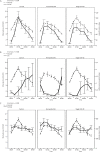A Metabolic Study of Huntington's Disease
- PMID: 26744893
- PMCID: PMC4706313
- DOI: 10.1371/journal.pone.0146480
A Metabolic Study of Huntington's Disease
Abstract
Background: Huntington's disease patients have a number of peripheral manifestations suggestive of metabolic and endocrine abnormalities. We, therefore, investigated a number of metabolic factors in a 24-hour study of Huntington's disease gene carriers (premanifest and moderate stage II/III) and controls.
Methods: Control (n = 15), premanifest (n = 14) and stage II/III (n = 13) participants were studied with blood sampling over a 24-hour period. A battery of clinical tests including neurological rating and function scales were performed. Visceral and subcutaneous adipose distribution was measured using magnetic resonance imaging. We quantified fasting baseline concentrations of glucose, insulin, cholesterol, triglycerides, lipoprotein (a), fatty acids, amino acids, lactate and osteokines. Leptin and ghrelin were quantified in fasting samples and after a standardised meal. We assessed glucose, insulin, growth hormone and cortisol concentrations during a prolonged oral glucose tolerance test.
Results: We found no highly significant differences in carbohydrate, protein or lipid metabolism markers between healthy controls, premanifest and stage II/III Huntington's disease subjects. For some markers (osteoprotegerin, tyrosine, lysine, phenylalanine and arginine) there is a suggestion (p values between 0.02 and 0.05) that levels are higher in patients with premanifest HD, but not moderate HD. However, given the large number of statistical tests performed interpretation of these findings must be cautious.
Conclusions: Contrary to previous studies that showed altered levels of metabolic markers in patients with Huntington's disease, our study did not demonstrate convincing evidence of abnormalities in any of the markers examined. Our analyses were restricted to Huntington's disease patients not taking neuroleptics, anti-depressants or other medication affecting metabolic pathways. Even with the modest sample sizes studied, the lack of highly significant results, despite many being tested, suggests that the majority of these markers do not differ markedly by disease status.
Conflict of interest statement
Figures
Similar articles
-
A 24-Hour Study of the Hypothalamo-Pituitary Axes in Huntington's Disease.PLoS One. 2015 Oct 2;10(10):e0138848. doi: 10.1371/journal.pone.0138848. eCollection 2015. PLoS One. 2015. PMID: 26431314 Free PMC article.
-
Liver function in Huntington's disease assessed by blood biochemical analyses in a clinical setting.J Neurol Sci. 2016 Mar 15;362:326-32. doi: 10.1016/j.jns.2016.02.018. Epub 2016 Feb 9. J Neurol Sci. 2016. PMID: 26944172
-
Growth hormone and ghrelin secretion are associated with clinical severity in Huntington's disease.Eur J Neurol. 2010 Feb;17(2):280-8. doi: 10.1111/j.1468-1331.2009.02798.x. Epub 2009 Oct 21. Eur J Neurol. 2010. PMID: 19845749
-
Growth hormone response to arginine test differentiates between two subgroups of Huntington's disease patients.J Neurol Neurosurg Psychiatry. 2011 May;82(5):543-7. doi: 10.1136/jnnp.2010.208553. Epub 2010 Sep 30. J Neurol Neurosurg Psychiatry. 2011. PMID: 20884675
-
Insulin sensitivity and early-phase insulin secretion in normoglycemic Huntington's disease patients.J Huntingtons Dis. 2013;2(4):501-7. doi: 10.3233/JHD-130078. J Huntingtons Dis. 2013. PMID: 25062734
Cited by
-
Neuroprotective Potential of Eugenol in Polyglutamine-Mediated Neurodegenerative Disease Using Transgenic Drosophila Model.Dose Response. 2024 Oct 13;22(4):15593258241291652. doi: 10.1177/15593258241291652. eCollection 2024 Oct-Dec. Dose Response. 2024. PMID: 39410958 Free PMC article.
-
Glycation in Huntington's Disease: A Possible Modifier and Target for Intervention.J Huntingtons Dis. 2019;8(3):245-256. doi: 10.3233/JHD-190366. J Huntingtons Dis. 2019. PMID: 31322580 Free PMC article. Review.
-
Rehabilitation outcomes in Huntington disease patients with low body mass index.J Musculoskelet Neuronal Interact. 2022 Mar 1;22(1):79-86. J Musculoskelet Neuronal Interact. 2022. PMID: 35234162 Free PMC article.
-
FAK and p130Cas modulate stiffness-mediated early transcription and cellular metabolism.bioRxiv [Preprint]. 2024 Jan 16:2024.01.15.575789. doi: 10.1101/2024.01.15.575789. bioRxiv. 2024. Update in: Cytoskeleton (Hoboken). 2025 Mar;82(3):197-215. doi: 10.1002/cm.21971. PMID: 38293187 Free PMC article. Updated. Preprint.
-
The Reversible Carnitine Palmitoyltransferase 1 Inhibitor (Teglicar) Ameliorates the Neurodegenerative Phenotype in a Drosophila Huntington's Disease Model by Acting on the Expression of Carnitine-Related Genes.Molecules. 2022 May 13;27(10):3125. doi: 10.3390/molecules27103125. Molecules. 2022. PMID: 35630602 Free PMC article.
References
-
- Aziz NA, Swaab DF, Pijl H, Roos RA. Hypothalamic dysfunction and neuroendocrine and metabolic alterations in Huntington's disease: clinical consequences and therapeutic implications. Rev Neurosci. 2007;18(3–4):223–51. - PubMed
-
- Petersen A, Bjorkqvist M. Hypothalamic-endocrine aspects in Huntington's disease. Eur J Neurosci. 2006;24(4):961–7. - PubMed
-
- Underwood BR, Broadhurst D, Dunn WB, Ellis DI, Michell AW, Vacher C, et al. Huntington disease patients and transgenic mice have similar pro-catabolic serum metabolite profiles. Brain. 2006;129(Pt 4):877–86. - PubMed
Publication types
MeSH terms
Substances
LinkOut - more resources
Full Text Sources
Other Literature Sources
Medical


